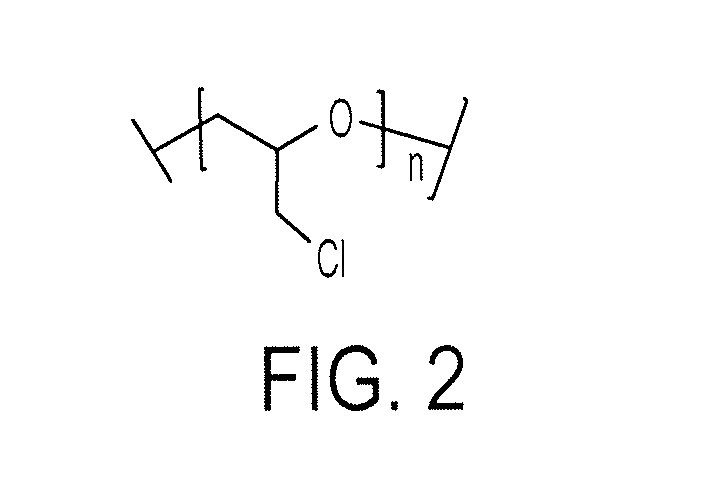Solid Organic Electrolytes
a technology of solid organic electrolytes and electrolyte, which is applied in the direction of electrolytic capacitors, electrochemical generators, light-sensitive devices, etc., can solve the problems of limiting the long-term stability and high temperature operation of dsscs, leakage of liquid electrolytes in dsscs, and desorption of dye molecules
- Summary
- Abstract
- Description
- Claims
- Application Information
AI Technical Summary
Benefits of technology
Problems solved by technology
Method used
Image
Examples
example 1
[0057]Synthesis of PEGylated / fluorinated imidazolium iodide (ZMlml). The three step reaction scheme is illustrated in Scheme 1.
[0058]Tosytation of PEGylated / fluorinated alcohol (Zonyl FSO-100, ZOH). ZOH (70 mmol) was dissolved in 100 mmol of anhydrous pyridine (Py) in a round bottom flask. The flask was cooled using an ice-water bath, and a solution of 100 mmol of tosyl chloride (TsCl) in 100 mL of methylene chloride was added drop-wise to the flask. A white precipitate was formed immediately after addition of tosyl chloride. After 1 h, the ice-water bath was removed and the reaction mixture was allowed to warm to room temperature. After about 24 h, 100 ml of methylene chloride was added to the reaction flask, and the mixture was stirred for 30 min. A clear separation of layers was observed. This mixture was washed (three times) with saturated sodium bicarbonate solution to extract any unreacted tosyl chloride. Pyridine was separated from the product by extraction using 1 M aqueous ...
example 2
[0064]Synthesis of PEGylated imidazolium iodides (mPEGnMlml). The three-step reaction scheme for the synthesis of the PEGylated imidazolium iodides is illustrated in Scheme 2.
[0065]Tosylation of mythoxy terminated poly(ethylene glycols)s (mPEG7, mPEG12 and mPEG16). mPEG (30 mmol) was dissolved in 60 mmol of pyridine in a round bottom flask. A solution of 60 mmol of tosyl chloride in 45 mL of methylene chloride was added drop-wise to the flask with cooling (˜0° C.). A white precipitate was formed immediately after addition of tosyl chloride. After 1 h, the reaction mixture was warmed to room temperature, and the reaction was allowed to continue further for 24 h at room temperature. 50 mL of methylene chloride were added to the reaction flask and stirred for half-hour. The reaction mixture was extracted with saturated sodium bicarbonate solution, followed by 1 M aqueous hydrochloric acid solution, and finally with distilled water (three times each). The organic phase was dried over so...
example 3
[0070]Synthesis of alkyl imidazolium iodides, 25 mmol of 1-methylimidazole were taken in a round bottom flask and sealed with a rubber septum. To this, 50 mmol of the iodoalkane was added drop-wise over a period of one hour using a syringe. The contents in the reaction flask immediately turned yellow for the reactions with propyl and hexyl iodide and green for the reaction with butyl iodide. The quaternization reaction proceeded with darkening in color of the contents. The reaction flask was deoxygenated with dry nitrogen gas for about 15 min and the reaction was allowed to run under nitrogen at 80° C. for 2 days. Excess alkyl iodide was washed with ethyl acetate to remove any unreacted reactants. The residual solvent was evaporated under vacuum and the product was further dried in a vacuum oven at 50° C. 1-Alkyl-3-methylimidazolium iodides were yellow liquids.
[0071]PrMlml: 1H NMR (400 MHz, CDCl3, δ): 1.01 (t, 3H, N+ (CH2)2CH3), 2.01 (m, 2H, N+CH2CH2—), 4.13 (t, 2H, N+CH2—), 7.49 (s...
PUM
| Property | Measurement | Unit |
|---|---|---|
| ionic conductivity | aaaaa | aaaaa |
| ionic conductivities | aaaaa | aaaaa |
| ionic conductivities | aaaaa | aaaaa |
Abstract
Description
Claims
Application Information
 Login to View More
Login to View More - R&D
- Intellectual Property
- Life Sciences
- Materials
- Tech Scout
- Unparalleled Data Quality
- Higher Quality Content
- 60% Fewer Hallucinations
Browse by: Latest US Patents, China's latest patents, Technical Efficacy Thesaurus, Application Domain, Technology Topic, Popular Technical Reports.
© 2025 PatSnap. All rights reserved.Legal|Privacy policy|Modern Slavery Act Transparency Statement|Sitemap|About US| Contact US: help@patsnap.com



